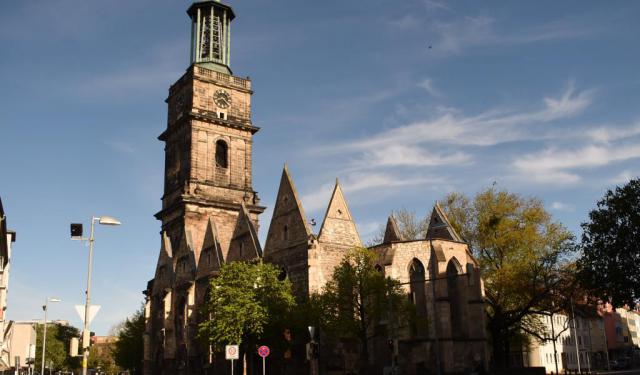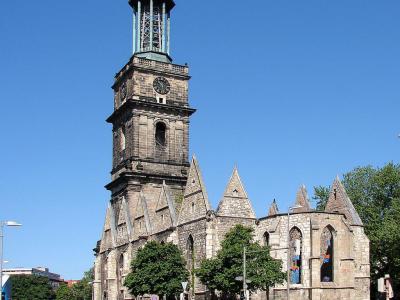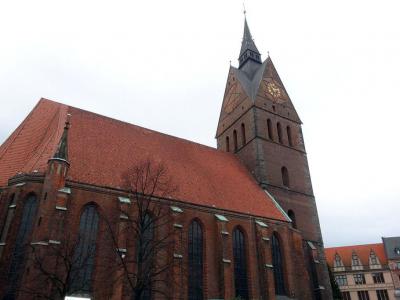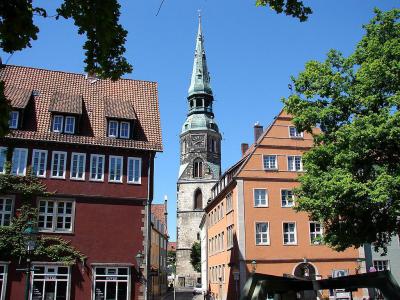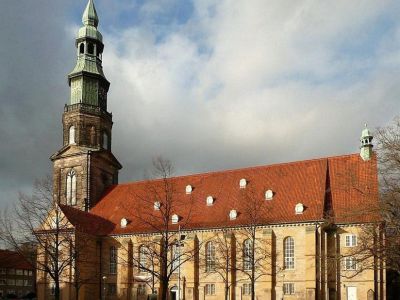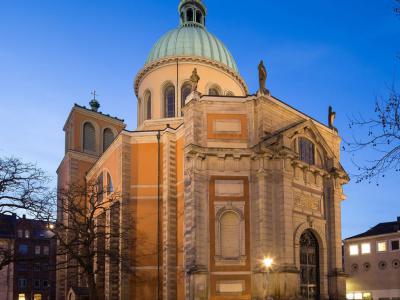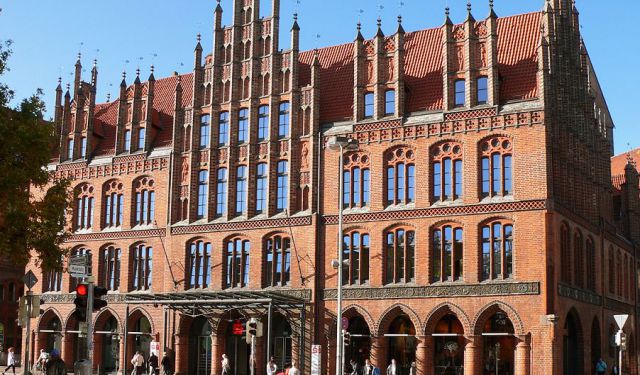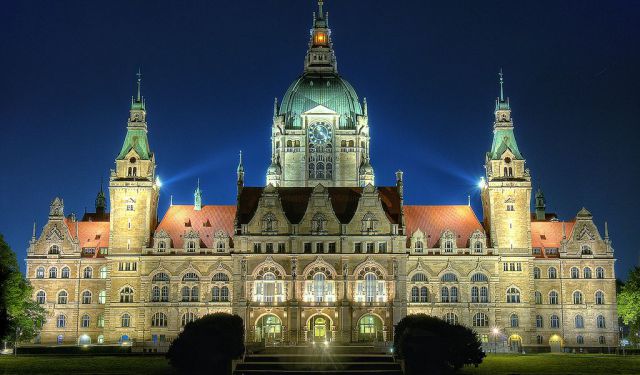Hannover's Historical Churches Walking Tour (Self Guided), Hanover
Hannover, Germany, boasts a great deal of history that is beautifully reflected in its ancient churches. A good number of them were built as far back as the 14th century. Despite the passage of time, today these architectural marvels remain largely intact, standing as a testament to Hannover's cultural and religious heritage.
One such is the Aegidia Church (Aegidienkirche). Originally built in the 1340s, during World War II it was heavily damaged and since then has been preserved as a peace memorial.
Also notable is the Market Church (Marktkirche). A stunning example of North German brick Gothic architecture, it has a prominent position in Hannover's history and continues to be a place of worship and cultural events.
The Holy Cross Church (Kreuzkirche) is another gem in the city's ecclesiastical landscape. Known for its serene atmosphere, this sanctuary provides a peaceful retreat for visitors and locals alike.
The New Town Church (Neustädter Kirche) is a splendid example of early Baroque. With its grand façade and matching interior, it symbolizes Hannover's artistic and architectural prowess.
Lastly, the Basilika Saint Clemens is a beautiful church that showcases Hannover's religious devotion. Its impressive structure and intricate details make it a must-go-to site for those interested in religious history.
As you explore Hannover, don't miss the opportunity to visit its historical churches. They not only offer a glimpse into the city's past but also provide a sense of tranquility and reflection. So, take a step back in time on this self-guided walk and immerse yourself in the richness of Hannover's religious architecture.
One such is the Aegidia Church (Aegidienkirche). Originally built in the 1340s, during World War II it was heavily damaged and since then has been preserved as a peace memorial.
Also notable is the Market Church (Marktkirche). A stunning example of North German brick Gothic architecture, it has a prominent position in Hannover's history and continues to be a place of worship and cultural events.
The Holy Cross Church (Kreuzkirche) is another gem in the city's ecclesiastical landscape. Known for its serene atmosphere, this sanctuary provides a peaceful retreat for visitors and locals alike.
The New Town Church (Neustädter Kirche) is a splendid example of early Baroque. With its grand façade and matching interior, it symbolizes Hannover's artistic and architectural prowess.
Lastly, the Basilika Saint Clemens is a beautiful church that showcases Hannover's religious devotion. Its impressive structure and intricate details make it a must-go-to site for those interested in religious history.
As you explore Hannover, don't miss the opportunity to visit its historical churches. They not only offer a glimpse into the city's past but also provide a sense of tranquility and reflection. So, take a step back in time on this self-guided walk and immerse yourself in the richness of Hannover's religious architecture.
How it works: Download the app "GPSmyCity: Walks in 1K+ Cities" from Apple App Store or Google Play Store to your mobile phone or tablet. The app turns your mobile device into a personal tour guide and its built-in GPS navigation functions guide you from one tour stop to next. The app works offline, so no data plan is needed when traveling abroad.
Hannover's Historical Churches Walking Tour Map
Guide Name: Hannover's Historical Churches Walking Tour
Guide Location: Germany » Hanover (See other walking tours in Hanover)
Guide Type: Self-guided Walking Tour (Sightseeing)
# of Attractions: 5
Tour Duration: 1 Hour(s)
Travel Distance: 1.6 Km or 1 Miles
Author: DanaOffice
Sight(s) Featured in This Guide:
Guide Location: Germany » Hanover (See other walking tours in Hanover)
Guide Type: Self-guided Walking Tour (Sightseeing)
# of Attractions: 5
Tour Duration: 1 Hour(s)
Travel Distance: 1.6 Km or 1 Miles
Author: DanaOffice
Sight(s) Featured in This Guide:
- Aegidienkirche (Aegidia Church)
- Marktkirche (Market Church)
- Kreuzkirche (Holy Cross Church)
- Neustädter Kirche (New Town Church)
- Propsteikirche Basilika St. Clemens (Basilika St. Clemens)
1) Aegidienkirche (Aegidia Church) (must see)
The Gothic-style Aegidien Church was built in 1347. It sits on the location of a 12th-century Romanesque church. Hanover's 16th century Reformation began in Aegidiean Church. In the early 1700s, a Baroque facade was added to the church's steeple. In 1826, Georg Ludwig Friedrich Laves remodeled the church's interior.
In 1943, the church was destroyed by World War II bombs. The church was left in ruins with only its outer walls intact. The church was not rebuilt after the war, rather it today functions as a war memorial. In 1959, Kurt Lehmann designed and installed a monumental sculpture called Humility.
The outer walls feature many Baroque epitaphs, including one dedicated to Susanna Magdalena Oldekop, who died as a child in 1648.
A relief known as the Siebenmannenstein shows seven praying men who allegedly sacrificed themselves to save the town. The men are known as "Hannover's Spartans," who died during an attack on Dohren Tower in 1480. The Siebenmannenstein relief is a copy. The original can be seen in the Hannover Historical Museum.
The contemplative Schattenlinie artwork features a white stone line that capture's the church's shadow. This artwork is a symbol of life and death, and of light and shadows.
Hiroshima, Japan, is Hanover's sister city. Hiroshima donated a peace bell to Hanover, and it is now located in the Aegidien Church's tower. It is rung every year on Hiroshima Day which is August 6th.
In 1943, the church was destroyed by World War II bombs. The church was left in ruins with only its outer walls intact. The church was not rebuilt after the war, rather it today functions as a war memorial. In 1959, Kurt Lehmann designed and installed a monumental sculpture called Humility.
The outer walls feature many Baroque epitaphs, including one dedicated to Susanna Magdalena Oldekop, who died as a child in 1648.
A relief known as the Siebenmannenstein shows seven praying men who allegedly sacrificed themselves to save the town. The men are known as "Hannover's Spartans," who died during an attack on Dohren Tower in 1480. The Siebenmannenstein relief is a copy. The original can be seen in the Hannover Historical Museum.
The contemplative Schattenlinie artwork features a white stone line that capture's the church's shadow. This artwork is a symbol of life and death, and of light and shadows.
Hiroshima, Japan, is Hanover's sister city. Hiroshima donated a peace bell to Hanover, and it is now located in the Aegidien Church's tower. It is rung every year on Hiroshima Day which is August 6th.
2) Marktkirche (Market Church)
Market Church was initially built in the 14th century. It was built in the North German brick gothic style and is Germany's southernmost example of this unique architectural style.
The church's tall western tower symbolized Hannover's wealth and power. The tower is one of Hannover's most recognizable landmarks. The tower has 11 bells. The Bell of Christ and Peace is Lower Saxony's largest bell and reserved for special occasions.
The church's interior features a carved wooden altar that dates to the late 15th century. The altar's front depicts the Passion of Christ. The altar's back shows scenes from the lives of Saint George and Saint James, the church's patron saints.
The church's roof and naves were damaged by World War II bombs in 1943 and were rebuilt in 1952.
The church's organ was built in 1954 and has 64 stops.
A giant pentagram on the church's western tower is one of its most dramatic elements. In addition, a hexagram surrounds the tower's clock. These symbols were used by ancient pagans and then adopted by early Christians. The pentagram was used to symbolize the epiphany.
Why You Should Visit:
Very impressive church with an imposing presence; easy to find and prettily placed in a lively space in town.
The interior is clean, the design is simple yet fascinating, and the organ is really beautiful.
Tip:
Try to be there when the organ plays – it's fantastic.
The church's tall western tower symbolized Hannover's wealth and power. The tower is one of Hannover's most recognizable landmarks. The tower has 11 bells. The Bell of Christ and Peace is Lower Saxony's largest bell and reserved for special occasions.
The church's interior features a carved wooden altar that dates to the late 15th century. The altar's front depicts the Passion of Christ. The altar's back shows scenes from the lives of Saint George and Saint James, the church's patron saints.
The church's roof and naves were damaged by World War II bombs in 1943 and were rebuilt in 1952.
The church's organ was built in 1954 and has 64 stops.
A giant pentagram on the church's western tower is one of its most dramatic elements. In addition, a hexagram surrounds the tower's clock. These symbols were used by ancient pagans and then adopted by early Christians. The pentagram was used to symbolize the epiphany.
Why You Should Visit:
Very impressive church with an imposing presence; easy to find and prettily placed in a lively space in town.
The interior is clean, the design is simple yet fascinating, and the organ is really beautiful.
Tip:
Try to be there when the organ plays – it's fantastic.
3) Kreuzkirche (Holy Cross Church)
The Holy Cross Church (Kreuzkirche), dating from 1284, is Hannover’s oldest parish church and is used for church services along with concerts and major events. Most of the construction that you see today is from around 1333 when it was extended according to an original Gothic design. It is well known for its decorative altar, which was painted by Lucas Cranach in 1537. In 1560, a large theological library was created in the basement of the church and increased space was made behind the vestry for the choir. There is an ornate Renaissance period pulpit that was added to the church in 1594.
A chapel in Baroque style was added to the church grounds in the 17th century and on the east side of the building, there is a stone emblem of the city of Hannover. One of the premier features of the church exterior is its large spire, reportedly damaged during a violent storm in 1630. In 1652, the spire was totally restored in Baroque style with funds provided by Johann Duve. Like much of the Old City, the Holy Cross Church sustained damage during bombing in World War II and was repaired between 1951-1961. The Holy Cross Church is one of the city’s most important churches and represents design elements of every major period – from medieval times to the 20th century.
Why You Should Visit:
Of course, not a Catholic church, or it would be decorated with gold from floor to ceiling, but still worth seeing if only to ascertain that a church is not meant for the accumulation of wealth.
Beautiful surroundings with great neighboring cafés, too!
A chapel in Baroque style was added to the church grounds in the 17th century and on the east side of the building, there is a stone emblem of the city of Hannover. One of the premier features of the church exterior is its large spire, reportedly damaged during a violent storm in 1630. In 1652, the spire was totally restored in Baroque style with funds provided by Johann Duve. Like much of the Old City, the Holy Cross Church sustained damage during bombing in World War II and was repaired between 1951-1961. The Holy Cross Church is one of the city’s most important churches and represents design elements of every major period – from medieval times to the 20th century.
Why You Should Visit:
Of course, not a Catholic church, or it would be decorated with gold from floor to ceiling, but still worth seeing if only to ascertain that a church is not meant for the accumulation of wealth.
Beautiful surroundings with great neighboring cafés, too!
4) Neustädter Kirche (New Town Church)
The New Town Church, also known as Saint John's Church, is a significant Lutheran church in Hanover. Constructed between 1666 and 1670, this Baroque structure is notable for being one of the earliest Protestant single-naved churches in Lower Saxony, designed primarily for delivering sermons, a key element in Lutheran worship. Notably, the church is the final resting place of the renowned mathematician and philosopher Gottfried Wilhelm Leibniz, as well as the military leader Carl August von Alten.
Architecturally, the church exemplifies an early Baroque style, drawing inspiration from classical antiquity. Its layout includes a long, spacious main hall ending in a slightly narrower chancel to the east, and features a large organ balcony at the western end and additional smaller balconies along its sides. Much of its rich interior decor, unfortunately, was lost during World War II.
The church is also celebrated for its musical contributions, particularly through the Saint John's chorale, which performs both in services and concerts. It's been a host for various significant events, including the Expo 2000 and the German Evangelical Church Assembly. In a unique collaboration with the Hanover University of Music, Drama and Media, a special organ was installed in 1998-2001. This organ, situated on the north balcony, is designed based on Spanish Baroque principles, making it ideal for early Baroque music, yet it doesn't replicate any specific historical instrument.
Architecturally, the church exemplifies an early Baroque style, drawing inspiration from classical antiquity. Its layout includes a long, spacious main hall ending in a slightly narrower chancel to the east, and features a large organ balcony at the western end and additional smaller balconies along its sides. Much of its rich interior decor, unfortunately, was lost during World War II.
The church is also celebrated for its musical contributions, particularly through the Saint John's chorale, which performs both in services and concerts. It's been a host for various significant events, including the Expo 2000 and the German Evangelical Church Assembly. In a unique collaboration with the Hanover University of Music, Drama and Media, a special organ was installed in 1998-2001. This organ, situated on the north balcony, is designed based on Spanish Baroque principles, making it ideal for early Baroque music, yet it doesn't replicate any specific historical instrument.
5) Propsteikirche Basilika St. Clemens (Basilika St. Clemens)
Saint Clement's Basilica (Propsteikirche Basilika Saint Clemens) holds a significant place in the history and religious landscape of Hanover. As the mother church of the Catholic diocese to which Hannover belongs, it stands as a testament to religious perseverance and architectural beauty.
Dedicated to Saint Clement of Rome, the construction of Saint Clement's Basilica began in 1712 and was completed in 1718. This marked a pivotal moment in the religious history of Hanover, as it was the first Roman Catholic church built in the city since the Reformation, an era that saw the Kingdom of Hanover adopt Protestantism.
However, the basilica's history is also marked by tragedy. During World War II, in 1943, the church was almost completely destroyed by the Allied bombings. These bombings targeted Hanover and other major German cities in a strategic effort to weaken the Nazi regime. The destruction of such a historic and religious site was a significant loss for the community.
Reconstruction efforts for the basilica began in 1946, in the aftermath of the war. The community's dedication to restoring this landmark was evident, and the newly completed church was rededicated on November 24, 1957. In a further acknowledgment of its importance, Pope John Paul II designated it as a Minor Basilica on March 12, 1998.
Architecturally, Saint Clement's Basilica is a standout structure in Hanover. Built in the Venetian Baroque style, it is unique in its design and is often referred to as the "Saint Peter of the North" due to its striking appearance and religious significance. This unusual shape and style make it easily distinguishable from other buildings in the city.
Dedicated to Saint Clement of Rome, the construction of Saint Clement's Basilica began in 1712 and was completed in 1718. This marked a pivotal moment in the religious history of Hanover, as it was the first Roman Catholic church built in the city since the Reformation, an era that saw the Kingdom of Hanover adopt Protestantism.
However, the basilica's history is also marked by tragedy. During World War II, in 1943, the church was almost completely destroyed by the Allied bombings. These bombings targeted Hanover and other major German cities in a strategic effort to weaken the Nazi regime. The destruction of such a historic and religious site was a significant loss for the community.
Reconstruction efforts for the basilica began in 1946, in the aftermath of the war. The community's dedication to restoring this landmark was evident, and the newly completed church was rededicated on November 24, 1957. In a further acknowledgment of its importance, Pope John Paul II designated it as a Minor Basilica on March 12, 1998.
Architecturally, Saint Clement's Basilica is a standout structure in Hanover. Built in the Venetian Baroque style, it is unique in its design and is often referred to as the "Saint Peter of the North" due to its striking appearance and religious significance. This unusual shape and style make it easily distinguishable from other buildings in the city.
Walking Tours in Hanover, Germany
Create Your Own Walk in Hanover
Creating your own self-guided walk in Hanover is easy and fun. Choose the city attractions that you want to see and a walk route map will be created just for you. You can even set your hotel as the start point of the walk.
Architectural Jewels
Even though some may find Hannover rather new looking, the city in fact has a long and eventful history. As a crucial transportation hub, Hannover couldn’t escape Allied bombing during World War II; what used to be a grand city was turned into the rubble – with 90% of the local buildings destroyed. Yet, despite the bombing and ensued reconstruction, many pre-war architectural gems have... view more
Tour Duration: 1 Hour(s)
Travel Distance: 1.5 Km or 0.9 Miles
Tour Duration: 1 Hour(s)
Travel Distance: 1.5 Km or 0.9 Miles
Shopping Areas in Hannover
Hannover is ideally suited for shopping – replete with wonderful markets and elegant boutiques fit to satisfy most shoppers. All the world's top brands are packed here within easily accessible areas. Only a few cities in Germany can offer such a high density of shopping opportunities within just a few hundred meters of each other.
Subject to your interest, you can find here what you need... view more
Tour Duration: 1 Hour(s)
Travel Distance: 1.9 Km or 1.2 Miles
Subject to your interest, you can find here what you need... view more
Tour Duration: 1 Hour(s)
Travel Distance: 1.9 Km or 1.2 Miles
Hanover Introduction Walking Tour
Hanover began in medieval times as a small village of fishermen on the banks of the River Leine. By the 13th century, it was a large town by the day's standards. The name, initially "Honovere," likely meant "high river bank".
The town's location is a natural crossroads in the region, with the river providing navigable routes and its location on the North German... view more
Tour Duration: 2 Hour(s)
Travel Distance: 2.3 Km or 1.4 Miles
The town's location is a natural crossroads in the region, with the river providing navigable routes and its location on the North German... view more
Tour Duration: 2 Hour(s)
Travel Distance: 2.3 Km or 1.4 Miles
The Most Popular Cities
/ view all
